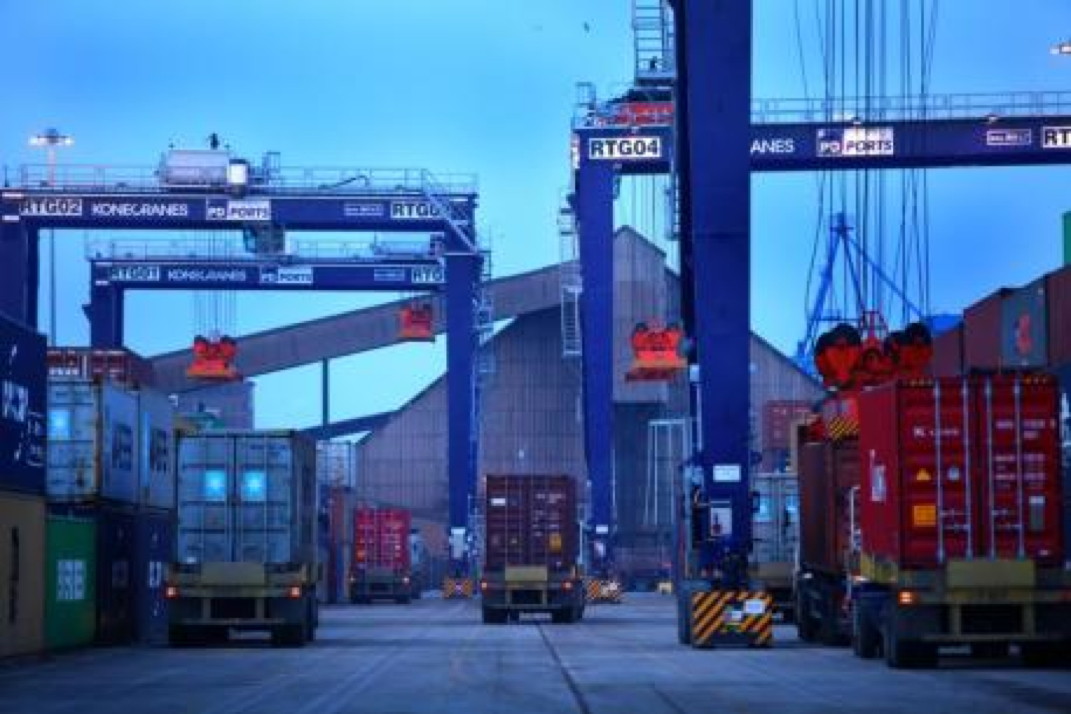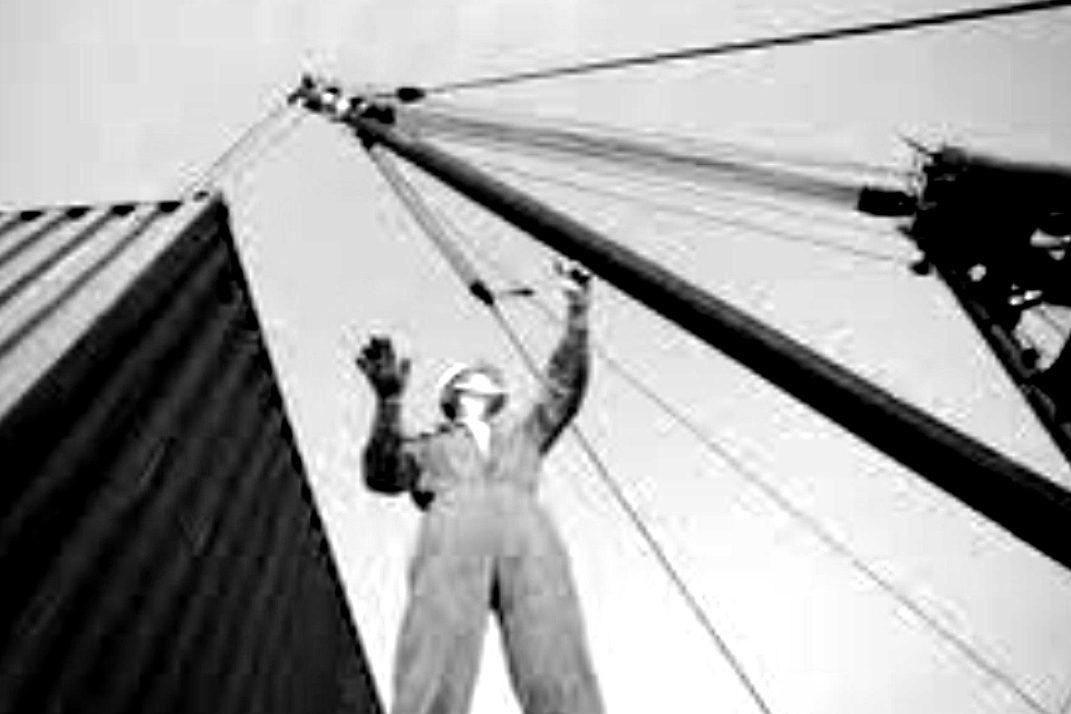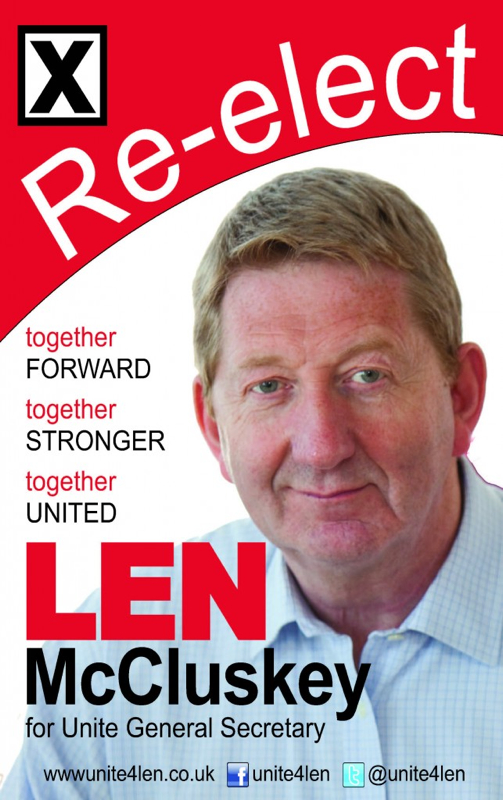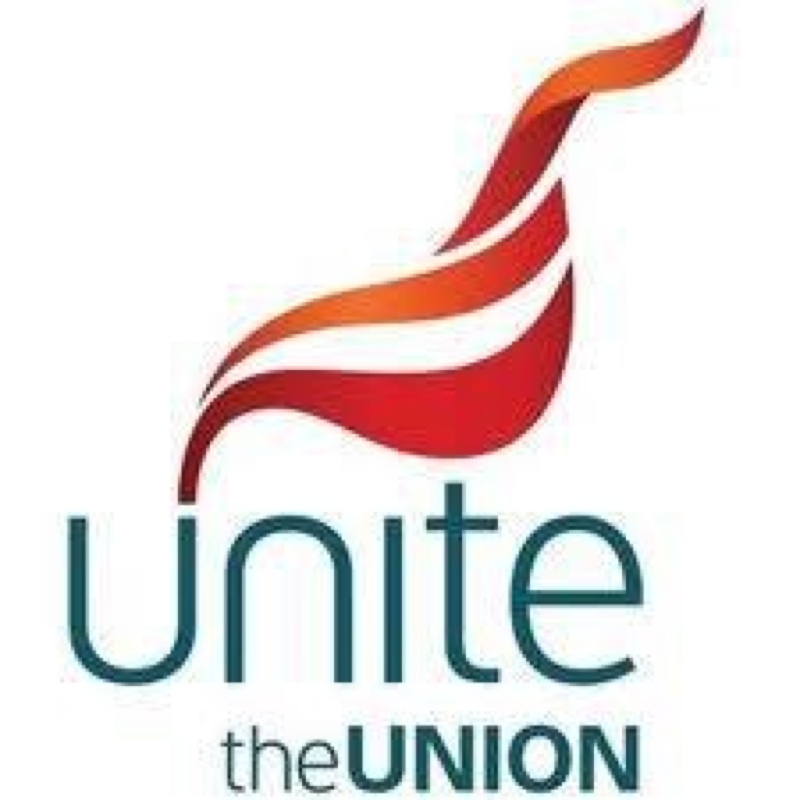NEW SYSTEM: The container terminal at Teesport, Teesside.
A HIGH-TECH solution has been introduced at Teesport to in a bid to help improve speed, agility and efficiency.
PD Ports has invested in a new terminal operating system at the Teesside port as part of signifies the completion of its £16.7m upgrade of its container terminal facilities.
The system, which is is now fully operational, was provided by specialist terminal operating software development company Navis for Teesport’s container terminal.
The implementation of the new system included areas of wide span gantry crane operations and portcentric logistics activities.
Frans Calje, PD Ports’ managing director, said: “As with any new system, which alters the way we operate, identifying and applying the Navis technology was not without its challenges. The collaboration of the project team, as well as those using the system on a daily basis, has produced a successful result so far with the system now fully operational at the terminal.
“The new terminal operating system signifies a fundamental change in how we do business at Teesport and enables us to give improved service to customers whilst allowing us to better plan and coordinate our container activities.
“This is a world leading platform and will facilitate growth in our container business at Teesport for many years to come.
“Our portcentric operations will benefit from the new system due to the ability to plan further ahead and offer greater visibility for our customers.”
Concerned about the of the way things are being ran in your workplace? (Bullying, Harrasment, Health and Safety Issues, Working Hours etc.)
Are you airing your concerns but seem to banging your head against a brick wall? Or are you seeing things that are concerning you and daren't speak up. If so PD PORTS and BROOKFIELD run a whistle blowing policy. It's a free phone number.
We are asking our members to use this number so we can high light our issues in the workplace: - 0808-234-2210
(The actual Policy will be available on the website in the coming days.)
The best advice currently available regarding shift-work schedule design and the workplace environment is summarised below. These guidelines are general though and set out goals to aim for. They cover a wide range of factors that may or may not be relevant to your particular industry sector. Therefore it is necessary to use common sense when applying them. You will also need to balance the good practice guidelines with the operational concerns of your own business. [More detailed background information and explanation for these guidelines is provided in HSE’s priced publication Managing Shift Work: Health and Safety Guidance, HSE Books 2006 ISBN 0 7176 6197 0]
Applying the good practice guidelines, so far as it is reasonably practicable to do so, will help reduce the risk that workers are exposed to by shift working.
Good practice guidelines for shift design
Plan an appropriate and varied workload.
Offer a choice of permanent or rotating shifts and try to avoid permanent night shifts.
Either rotate shifts every 2-3 days or every 3-4 weeks - otherwise adopt forward rotating shifts.
Avoid early morning starts and try to fit shift times in with the availability of public transport.
Limit shifts to 12 h including overtime, or to 8 h if they are night shifts and/or the work is demanding, monotonous, dangerous and/or safety critical.
Encourage workers to take regular breaks and allow some choice as to when they are taken.
Consider the needs of vulnerable workers, such as young or aging workers and new and expectant mothers.
Limit consecutive work days to a maximum of 5 - 7 days and restrict long shifts, night shifts and early morning shifts to 2-3 consecutive shifts.
Allow 2 nights full sleep when switching from day to night shifts and vice versa.
Build regular free weekends into the shift schedule.
Good practice guidelines for the work environment
Provide similar facilities as those available during daytime and allow shift workers time for training and development.
Ensure temperature & lighting is appropriate and preferably adjustable.
Provide training and information on the risks of shift work and ensure supervisors and management can recognise problems.
Consider increasing supervision during periods of low alertness.
Control overtime, shift swapping and on-call duties and discourage workers from taking second jobs.
Set standards and allow time for communication at shift handovers.
Encourage interaction between workers and provide a means of contact for lone workers.
Encourage workers to tell their GPs that they are shift workers and provide free health assessments for night workers.
Ensure the workplace and surroundings are well lit, safe and secure.
Why is fatigue inportant.?
More than 3.5 million people are employed as shift workers in the UK. They work in a wide variety of industries including the emergency services, healthcare, the utilities, transport, manufacturing (including oil, gas & chemical industries), entertainment and retail. Poorly designed shift-working arrangements and long working hours that do not balance the demands of work with time for rest and recovery can result in fatigue, accidents, injuries and ill health.
Fatigue refers to the issues that arise from excessive working time or poorly designed shift patterns. It is generally considered to be a decline in mental and/or physical performance that results from prolonged exertion, sleep loss and/or disruption of the internal clock. It is also related to workload, in that workers are more easily fatigued if their work is machine-paced, complex or monotonous.
Fatigue results in slower reactions, reduced ability to process information, memory lapses, absent-mindedness, decreased awareness, lack of attention, underestimation of risk, reduced coordination etc. Fatigue can lead to errors and accidents, ill-health and injury, and reduced productivity. It is often a root cause of major accidents e.g. Herald of Free Enterprise, Chernobyl, Texas City, Clapham Junction, Challenger and Exxon Valdez.
Fatigue has also been implicated in 20% of accidents on major roads and is said to cost the UK £115 - £240 million per year in terms of work accidents alone.
Key principles in fatigue
Fatigue needs to be managed, like any other hazard.
It is important not to underestimate the risks of fatigue. For example, the incidence of accidents and injuries has been found to be higher on night shifts, after a succession of shifts, when shifts are long and when there are inadequate breaks.
The legal duty is on employers to manage risks from fatigue, irrespective of any individual’s willingness to work extra hours or preference for certain shift patterns for social reasons. Compliance with the Working Time Regulations alone is insufficient to manage the risks of fatigue.
Changes to working hours need to be risk assessed. The key considerations should be the principles contained in HSE’s guidance. Risk assessment may include the use of tools such as HSE’s ‘fatigue risk index’.
Employees should be consulted on working hours and shift patterns. However, note that employees may prefer certain shift patterns that are unhealthy and likely to cause fatigue.
Develop a policy that specifically addresses and sets limits on working hours, overtime and shift-swapping, and which guards against fatigue.
Implement the policy and make arrangements to monitor and enforce it. This may include developing a robust system of recording working hours, overtime, shift-swapping and on-call working.
Problems with overtime and shift-swapping may indicate inadequate resource allocation and staffing levels.
There are many different shift work-schedules and each schedule has different features. This sheer diversity of work and workplaces means that there is no single optimal shift system that suits everyone. However, a planned and systematic approach to assessing and managing the risks of shift work can improve the health and safety of workers.
There are a number of key risk factors in shift schedule design, which must be considered when assessing and managing the risks of shift work. These are the workload, the work activity, shift timing and duration, direction of rotation and the number and length of breaks during and between shifts. Other features of the workplace environment such as the physical environment, management issues and employee welfare can also contribute to the risks associated with shift work.
Sleep disturbances can lead to a ‘sleep debt’ and fatigue. Night workers are particularly at risk of fatigue because their day sleep is often lighter, shorter and more easily disturbed because of daytime noise and a natural reluctance to sleep during daylight.
Because of the above information we are desperately seaking members to become Unite Health & Safety reps. (To start taking charge of OUR working environment.)
Full training will be provided, see you workplace rep for more information.
Can a person be left alone at their place of work?
There are no absolute restrictions on working alone; it will depend on the findings of a risk assessment.
There are two main pieces of legislation that will apply:
The Health and Safety at Work etc Act 1974: Section 2 sets out a duty of care on employers to ensure the health, safety and welfare of their employees whilst they are at work.
The Management of Health and Safety at work Regulations 1999: Regulation 3 states that every employer shall make a suitable and sufficient assessment of -
the risks to the health and safety of his employees to which they are exposed whilst they are at work; and
the risks to the health and safety of persons not in his employment arising out of or in connection with the conduct by him of his undertaking
The HSE have produced the following publication:
Working Alone in Safety - free leaflet
Although there is no general legal prohibition on working alone, the broad duties of the HSW Act and MHSW Regulations still apply. These require identifying hazards of the work, assessing the risks involved, and putting measures in place to avoid or control the risks.
Control measures may include instruction, training, supervision, protective equipment etc. Employers should take steps to check that control measures are used and review the risk assessment from time to time to ensure it is still adequate.
When risk assessment shows that it is not possible for the work to be done safely by a lone worker, arrangements for providing help or back-up should be put in place. Where a lone worker is working at another employer's workplace, that employer should inform the lone worker's employer of any risks and the control measures that should be taken. This helps the lone worker's employer to assess the risks.
Risk assessment should help decide the right level of supervision. There are some high-risk activities where at least one other person may need to be present. Examples include some high-risk confined space working where a supervisor may need to be present, as well as someone dedicated to the rescue role, and electrical work at or near exposed live conductors where at least two people are sometimes required.
Lone workers should not be at more risk than other employees. This may require extra risk-control measures. Precautions should take account of normal work and foreseeable emergencies, e.g. fire, equipment failure, illness and accidents. Employers should identify situations where people work alone and ask questions such as:
Does the workplace present a special risk to the lone worker?
Is there a safe way in and a way out for one person? Can any temporary access equipment which is necessary, such as portable ladders or trestles, be safely handled by one person?
Can all the plant, substances and goods involved in the work be safely handled by one person? Consider whether the work involves lifting objects too large for one person or whether more than one person is needed to operate essential controls for the safe running of equipment.
Is there a risk of violence?
Are women especially at risk if they work alone?
Are young workers especially at risk if they work alone?
Is the person medically fit and suitable to work alone?
What happens if the person becomes ill, has an accident or there is an emergency?
Over the next few weeks Unite members and activists will have the chance to nominate candidates and vote in the forthcoming election for General Secretary.
Unite’s current General Secretary, Len McCluskey, is standing for re-election. He has set out the reasons why in a Statement to the Executive Council and why the election should take place in 2013.
I intend to fully support and campaign for Len McCluskey’s re-election.
Here are the reasons why.
Unite has faced significant challenges in Manufacturing: in Aerospace, Shipbuilding, Defence, Engineering, Electrical Engineering, Electronics, Steel, Metals, Chemicals, Oil, Pharmaceuticals, Servicing, Print, Packaging, Papermaking, Media, Information Technology, Communications, Automotive’s, Components and in General Manufacturing.
These challenges include defending our members jobs, pay and conditions, fighting for decent pay increases, and fighting for skills and apprenticeships to provide decent jobs. Its been harder because of the lack of any overall Government strategy to help manufacturing.
In all of these fights and campaigns, Unite members and officials have received the full support of Len McCluskey:
At Honda in Swindon, Unite fought off a direct challenge to union recognition and an attempt to dismiss our most senior rep at the company. Len was directly involved with myself and other officials in negotiations with the company – giving the authority and support to mount a massive leverage campaign to defend our union and our reps.
At MMP on Merseyside over 140 print workers were illegally ‘locked-out’ by their company. Len was at the forefront, supporting a concerted leverage campaign against MMP, meeting with the Austrian directors of the company on their home turf, and helping broker an honourable settlement that our members overwhelmingly accepted.
At BAE Systems in Brough, Humberside, Len has given his full personal and political support to our members still fighting to save skilled engineering jobs at this strategically important site.
There are many other examples that didn’t make the headlines. But Len has supported the full use of the union’s financial, industrial, political and international strength to support members in dispute – wherever they are – in multi-nationals or in small and medium sized companies.
Under Len McCluskey’s leadership Unite has:
Introduced the payment of £30 a day strike pay to members in dispute, defending jobs or seeking to advance their pay and conditions;
Supported the defence of jobs in the UK automotive industry in order to build an industry with a real future;
Support a strategy for the UK Oil industry to ensure that there are no more Coryton’s;
Support for Unite’s ‘2020 Vision’ manufacturing strategy in the face of a Coalition Government bereft of an industrial strategy – a Government who are prepared to see well paid, skilled jobs go while attacking our members basic employment rights.
Unite was built on “three pillars” – Organising, International and Political. They are fundamental to our union’s structure.
Organising
Like many unions Unite’s membership has been hit by job losses. Len McCluskey has driven our 100% Organising campaign, across the union. This is building union strength where it is most needed – in the workplace. The result? 50,000 new members have joined the union – 17,500 manufacturing workers amongst them.
In addition Len has thrown his support behind organising campaigns, which have won union recognition and rights to information and consultation, building union membership.
International
Our global union with the United Steelworkers, Workers Uniting is developing all the time. Len McCluskey fully supports the need to build a global union. As the joint chair of Workers Uniting (with Leo Gerard of the Steelworkers in the USA and Canada) he has made sure Workers Uniting is a success – with joint initiatives to defend and support workers and their families in industries where Unite and the United Steelworkers are represented.
Len has been behind Workers Uniting joint initiatives, involving Unite women members, young members, members from ethnic minorities, members with disabilities and LGBT members.
Political
For too long our members and activists have argued that we need more working people representing us in parliament, in local councils, in the Welsh Assembly, in the Scottish Parliament and in the Europe Parliament.
Under Len McCluskey’s leadership the process is underway to ensure we get more working class people into power to represent ordinary members and their families.
Using our political strengths Len has supported initiatives to get manufacturing back onto the political agenda. Remember how New Labour didn’t want to know about manufacturing until it was almost too late? With the pressure from Unite, manufacturing is back high on the the agenda. Politicians now want to speak to us about manufacturing, skills, apprenticeships and employment rights. The door is no longer closed.
Under Len McCluskey’s leadership of our union we have seen a re-structuring to ensure we function in the best interests of members, and Unite now has a ‘fit for purpose’ financial structure and legal service.
Len has also widened the involvement of our young members in the union; pioneered community membership; introduced a political “think tank” – and we are introducing a new credit union.
There is still much to do but I believe Len McCluskey has shown the vision and determined leadership to get the union moving forward – a union our members can be proud of.
That is why we are supporting Len McCluskey and will be for his re-election as General Secretary of our union.
Website: www.Unite4len.co.uk
Facebook: Unite4Len
Twitter: @unite4len
The 485ft (148m) Baltic Ace collided with the 440ft (134m) container ship Corvus J near busy shipping lanes some 40 miles off the coast of the southern Netherlands.
Baltic Ace, which was heading from the Belgian port of Zeebrugge to Kotka in Finland, sank shortly after the collision.
Corvus J was on its way from Grangemouth in Scotland to Antwerp, Belgium, and was also damaged but assisted in the search for the missing crew of the sunken ship immediately afterwards.
"We can confirm that four bodies have been found, along with 13 people rescued alive," said coastguard spokesman Marcel Oldenburger.
A major air and sea rescue operation involving several helicopters, planes and two navy patrol ships has resumed.
"Given the water temperature and the amount of time that's passed, we don't have any hope for more survivors, said coastguard spokesman Peter Westenberg.
It is thought some of the crew may have gone down with the stricken vessel.
Earlier, rescuers pulled four bodies from the sea, before suspending the search overnight.
Some 13 crew members were also rescued from the Baltic Ace despite strong winds and waves of up to 9.8ft (3m) hampering the operation.
Four were flown to a hospital in Rotterdam, seven taken by rescue helicopter to a hospital in Belgium and two were being treated on board a ship that found them.
Mr Oldenburger said they were "all in shock" and suffering from hypothermia, but their lives were not in danger.
The cause of the collision is not known.
The shipping lane where the accident happened is one of the busiest in the North Sea and an important passing point for ships sailing into Rotterdam port, Europe's largest and the fifth-largest in the world.
Some employers recognise the benefits of promoting their employees' health, fitness and well-being rather than simply responding to individual employee health problems when they arise. But with the recession and cuts in public spending, have employers been cutting back in this area, or are they taking a more pro-active approach? Please tell us what happens at a workplace that you are involved with. Fill the survey in by clicking on the link below. It only takes 5 mins. Thank you www.lrd.org.uk/surveys/health/
We are still desperately seeking a rep for Bulks. There are a lot of complaints coming in about.
Excessive hours, harassment, abuse of days off etc.
If somebody is willing to stand up and start to fight back on your behalf, you will win and you will start to see change in your workplace. Especially if you ALL stand together. (Just look at the Ferry Terminal, TCT are starting to get there.)
Before people say, "The last lads who done it got the sack."
Nobody at Tees dock has EVER been sacked for being a Union Rep. So that is utter rubbish
"You become a target". You will only become a target if you put one on your head. If you do things using the proper channels and process, how can you become a target? You have legal rights as Union rep. These are available on the bulks web site page.
Please think about lads, YOU can't keep letting them getting away with it.. Grow some balls, stand up and fight back. The Port Council will be there to assist, but we can't do it for you.
Next week, together with union activists, Ian Murray MP will be delivering a huge letter right to the door of Number 10 Downing street, saying ‘our rights at work are not for sale’.
This Tory government are forcing through their plan to allow some businesses to force new employees to give up some of their most crucial rights at work, in return for shares in the business.
This is your last chance to add your name to the letter before we deliver it to Cameron’s front door:
http://www.unionstogether.org.uk/notforsale
If this clause in the Growth and Infrastructure Bill goes through, then we could see working people bribed by their employers to give up some of the most fundamental workplace protections, including:
· The right not to be sacked unfairly.
· Redundancy pay and redundancy rights.
· The right to request flexible hours to fit round family or caring responsibilities.
· The right to request training.
· Some maternity rights.
Labour MPs have been fighting this Bill in the House of Commons, like we’ve been fighting this government’s attacks on working people’s employment rights in other legislation. Rights are not something that can be traded for cash. We need an equal One Nation Britain where employees are valued and respected in all workplaces.
In this time of economic hardship and high unemployment, it beggars belief that the government keep coming up with new ideas for making it easier to sack people – when they don’t have a plan at all for how to grow the economy and create jobs. We want the Government to make it easier to hire not fire employees.
Will you add your name to our letter to Cameron and Osborne, saying ‘our rights at work are not for sale’?
http://www.unionstogether.org.uk/notforsale
Together, we can send the government a message that we won’t stand for this attack on our rights.
Thank you for your support,
Ian Murray MP
Labour’s Shadow Minister for Employment Rights
|




 RSS Feed
RSS Feed